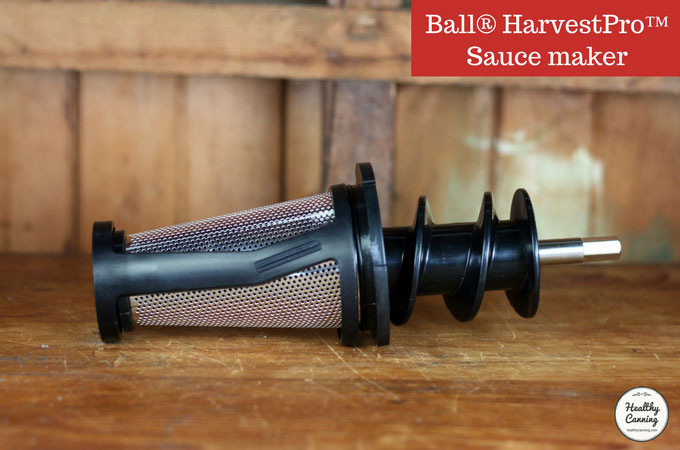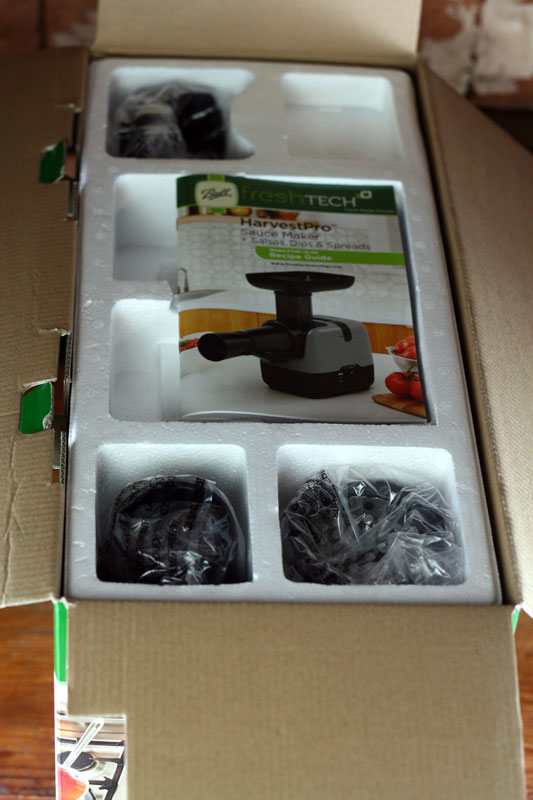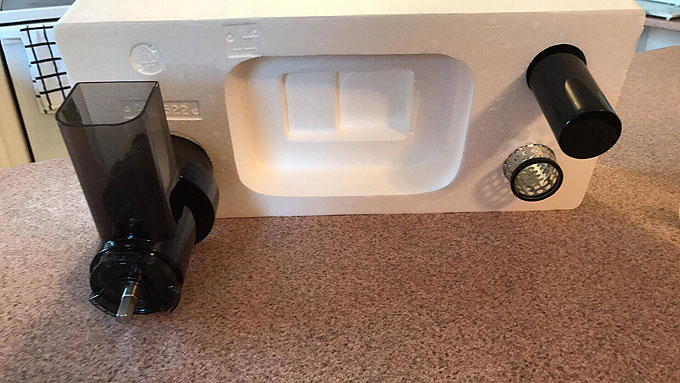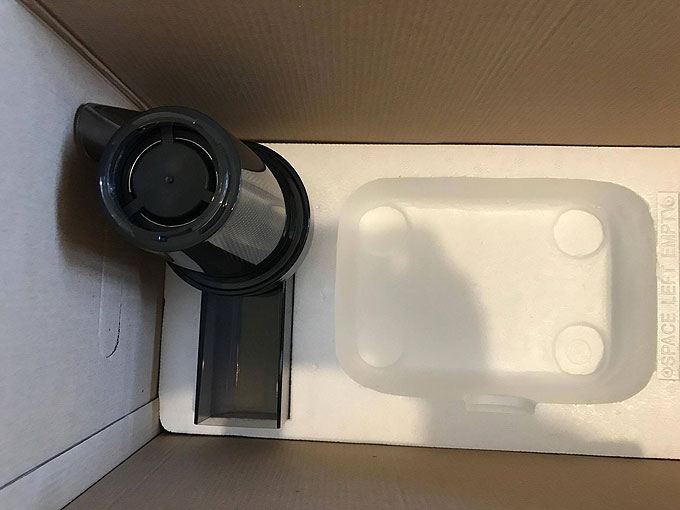The Ball® HarvestPro™ Sauce Maker is a good mid-range tomato mill product, and very good value for its price point.
It’s among the least expensive of the electric food mills, but comes with some very desirable features, such as a splash cover, a wide chute, a blade that automatically cleans the grinding screen as it works, and it is very, very quiet.
Replacement parts (as of 2020) could be an issue since this was first reviewed in 2016; see section on replacement parts.
Note that the machine is just not up to everything that a full-fledged food mill would be: it is not strong enough for instance to process grapes or blackberries without literally breaking some of the pieces.
- 1 Replacement parts
- 2 Comparison with other brands
- 3 Top features
- 4 Using the machine with tomatoes
- 5 Other uses for the machine
- 6 Caution about frozen produce
- 7 Produce to avoid
- 8 Salsa consistency
- 9 Setup with bowls in place ready for use
- 10 The manual and recipe book
- 11 Recipe book clarification
- 12 The pieces
- 13 Assembling the nozzle
- 14 Assembling for sauce making
- 15 Assembling for salsa making
- 16 Putting the assembly into the machine
- 17 The packaging
- 18 Fitting the HarvestPro back in the box
- 19 Where to buy the Ball® HarvestPro™ Sauce Maker
Replacement parts
When we first reviewed this machine, Ball supported it with the full array on replacement parts available right from its web site. They no longer sell anything on their website at all (2020).
2021 update: From about 2015 to 2020, replacement parts were sold on the Walmart website. but as of 2021, all replacement parts for this have disappeared from there. Internet searches have not turned up alternative sources for parts.
We think this could be absolute cause for concern when purchasing this product.
Comparison with other brands
The Ball Sauce Maker has a 150 watt motor and is advertised as being capable of producing 15 litres / quarts of tomato purée in 20 minutes.
There are far more expensive models of tomato mills available, costing up to hundreds and hundreds of dollars. The more expensive models do have more powerful engines and are capable of doing 300 to 600 lbs (135 to 270 kg) of tomatoes per hour, but they have their downsides, too: no splash cover, not auto cleaning blade, and far, far noisier.
Top features
- The metal grinding blades (called “screens”) are made of stainless steel;
- Cleaning blade helps to keep grating screens clean during operation;
- Has a forward and reverse feature, to help clear clogs;
- A wide chute;
- A generously sized hopper at the top;
- Quieter than a blender or food processor;
- The machine is very clean to use. There is no dripping that happens outside of where stuff is supposed to come out, and no food splattering everywhere. All the mess is very tidily contained;
- Clean-up is very easy as well. Everything except the motor (obviously) is dishwasher-safe;
- The machine is made in China, but clearly to very high standards.
Using the machine with tomatoes
In our first run, with Roma tomatoes, the machine extracted about 7 litres / quarts of juice from 8 kg / 17 lbs of tomatoes.
Ball advises that you can do a second pass of the solids through the machine. We would add that you probably definitely want to do this, as the second pass can get a significant quantity of some very thick quality tomato sauce out of these solids. As the solids are drier, though, they can stick a bit: so save a unpressed few tomatoes from the first pass, and use them to help lubricate the second pass. A third pass proved pointless.
Ball advises that you should heat the tomatoes first before putting them through the machine to get more out of them. “Wash tomatoes, core and cut into quarters. Cook in large stockpot over medium heat until softened. Remove from heat and allow to cool. Process tomatoes through the appliance.” [1]Sauce Maker book, 2016. Page 3.
This heating advice may be disappointing to some who thought they were going to skip that whole pot prep stage thanks to this machine. Note though that some reviewers on Amazon have said that they have just put washed, fresh quartered or halved completely raw tomatoes through, and been happy with the output after putting the residue through the machine a second time.
Other uses for the machine
The coarse attachment is for salsa. If you really want a chunky salsa, you should stick with using a food processor. This attachment will produce a “soupier” salsa, more like gazpacho soup texture.
Some uses (both canning and non-canning combined) include:
- Apple sauce
- Baby food
- Dips
- Gazpacho
- Pasta sauce
- Puréed soups
- Tomato juice
- Salsas
Caution about frozen produce
Do not put anything frozen through this machine! Make sure it is completely thawed first!
It’s normal during the harvest season to freeze produce until you have time to deal with it for canning.
But, do not put anything in a frozen state through this machine. Though the motor seems like it can handle it, the grinding attachments will not. The hardness will cause the pieces to break, even if the produce is partially thawed. Make sure the food stuffs going through are all 100% thawed.

Ball HarvestPro Saucemaker broken parts. Screen, and black “wiper brush with blades”
Above, you can see the results of what a tomato still semi-frozen mistakenly fed into the machine did: it broke two parts: the metal part that Ball calls the “screen”, and the black plastic frame that Ball calls the “wiper brush with blades.”
The parts are inexpensive enough to replace, but the time it takes to get them will almost certainly be too long for them to arrive in time for the produce you are currently canning.
Produce to avoid
Avoid grapes and blackberries in the machine.
Putting muscadine grapes through for juice jammed the machine’s sauce assembly. It is unclear if it were all the grape skins causing the jamming, or the seeds: muscadines are known for their very hard seeds.
Some other food mills (such as those from Villaware, and Victorio) come with optional “grape spirals” which you can purchase separately, which are meant to prevent such jamming with grape seeds. Perhaps one day Ball will offer one as an accessory, too.
Blackberry seeds, which are plentious and hard, also jammed the machine for us so solidly that we wondered if we’d have to trash the whole machine.
To solve the blackberry seed jamming, we pulsed the forward and reverse button to gently rock the grinder back and forth, back and forth, over a period of several minutes, to loosen things inside, and then brute force to loosen the mechanisms.
Raspberries, however, were fine: their seeds are finer and softer.
Salsa consistency
The recipe manual for this machine gives a recipe for Pico de Gallo.
This is a photo of how the combination of the main ingredients — seeded Roma tomato, onion, and pepper, fed through together as directed — came out of the machine. There’s no added lime juice, vinegar or other liquid yet: this is direct from the nozzle of the machine.
Setup with bowls in place ready for use
Below is a photo of the sauce attachment in place, ready for action. You need to supply your own bowls. The tall white bowl is in place, ready to catch the sauce that comes out the side. The bowl at the front is ready to catch the residue of skins and seeds that will slowly chug out of the front nozzle.

Setup with bowls (supplied by you.) Notice the button on the side of the machine. Press and release the top of the button to make the machine to start. If you need to clear the graters, press the bottom of the button to put the machine into reverse. You have to hold that down; when you release it, reverse will stop.
The manual and recipe book

One half of the book is recipes.

Flip the manual over, and the over half is a usage and care manual

The first recipe in recipe half of the book.
Recipe book clarification
The recipe book that comes with the machine has 15 canning recipes in it, and other non-canning recipes for soups, dip, baby food, etc.
In several of the canning recipes, citrus juices are called for, and it’s not always clear whether fresh or bottled is meant. We spoke with Ball, who clarified the issues for us. [2]Mary Jo at Ball. Email on file, 26 September 2016.
- Basic Tomato Sauce (page 3) calls for citric acid or *bottled* lemon juice (that’s clear);
- Tomato paste (page 4) calls for citric acid or *bottled* lemon juice (that’s clear);
- Marinara sauce (page 5) calls for citric acid or *lemon juice* (bottled lemon juice is meant);
- Pico de gallo (page 9) calls for “lime juice” (bottled lemon juice is meant);
- Roasted Salsa Verde (page 9) calls for “lime juice” (bottled lemon juice is meant);
- Apple sauce (page 9 calls) for 3 tbsp of “lemon juice” (fresh or bottled is fine);
- Mango Salsa (page 10) calls for “lime juice” (bottled lemon juice is meant);
- Barbeque sauce (page 11) calls for lime juice (fresh or bottled is fine);
- Jam recipes call for lemon juice” (fresh or bottled is fine).
The book does give some weight measurements but there is no metric. Those purchasing this machine in other countries such as the UK, Australia, New Zealand, South Africa, etc may wish to make sure they have access to North American measuring cups to use the recipes as ½ cup lime juice will be called for, without clarifying that that is also 125 ml / 4 oz.
You do NOT need to use this machine only for the recipes in the recipe book. They are supplied just to get you started thinking about how to use the machine. You can use this machine with just about any recipe, canning or non-canning, that calls for food to be passed through a food mill.
The pieces
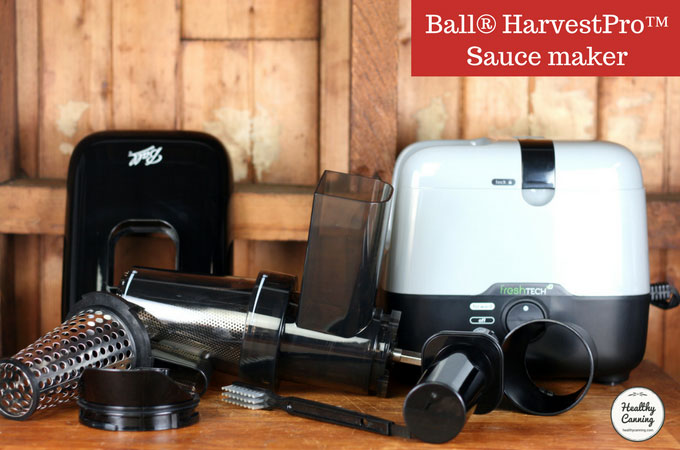
Here’s all the pieces — though you would never use them all at once.

Ball refers to the two metal grating cylinders as the “screens.” Perched on top of them is the blade cleaner that rotates around them during operation to scrape food off them.
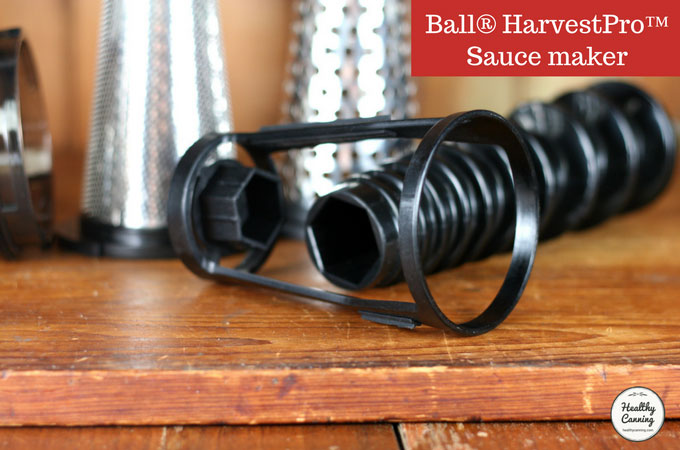
This is the cleaning blade, which rotates around the grating screens to help keep them from clogging

The cleaning brush that comes with the machine. It’s essentially a coarse-bristle toothbrush, with a pick on the end of the handle. We found that a bog-standard washing-up brush did a better job than this, but not all households may have such a brush for dishes.
Assembling the nozzle
There are two different ways to assemble the nozzle. One is for sauce (“splash guard processing”) with the fine screen, the other is for salsa (“lock ring processing”) with the coarse screen.
The only parts in common between the two assemblies are the auger, the chute, and the hopper.
Assembling for sauce making
The fine screen is used for sauce making, with a plastic cover to prevent splashing and two nozzles to separate solids from liquids.

The fine screen is for sauce, though if you want a coarser, more rustic sauce or a chili sauce, the coarse screen will fit into this assembly equally as well.

Once you realize the arrow on the transparent grey plastic parts is the key to things, the parts are really easy to lock together. You line up the parts so that that big grey arrow lines up with the picture of the opened lock, and then simply twist the part so that the arrow moves to line up with the locked lock.
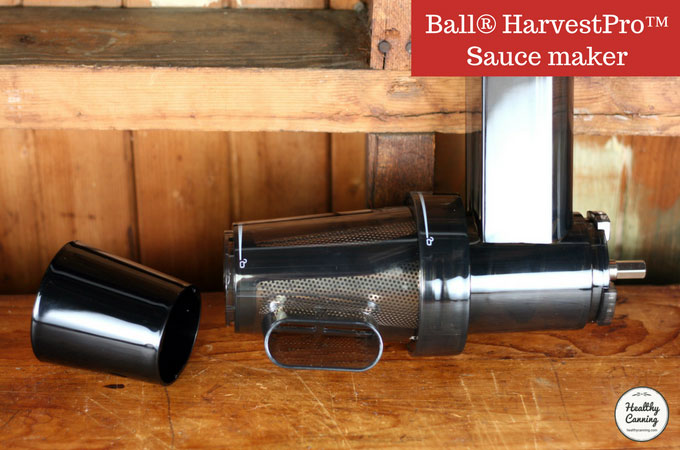
The front black nozzle locks in on the same way: twist to match an arrow up with the locks.

You absolutely want to put that last solid black part of the nozzle on (the “extension cone”), otherwise the overall assembly may be too short and allow residue to plop into your sauce bowl

Add the hopper on.

Attach to the machine. Notice in the middle top of the machine the black lock button has been pressed down into place.
Assembling for salsa making
The coarse screen is used for salsa, with no cover over the screen, and no separation of solids and liquids.
Putting the assembly into the machine

Pull the black lock down after you have inserted the spindle. Don’t try to force the lock. If you have to force it, stop: you haven’t seated the spindle properly. Try seating it again.

The assembly is seated fully. The lock can now be pulled down to lock the assembly in place.
The packaging
Ball recommends storing the sauce maker in the original box (Sauce maker manual, page 9, #9). If you are going to do this, as you unpack it, you may wish to take photos with your phone, etc, of where the parts where stored, so that you’ll have those photos for future reference.
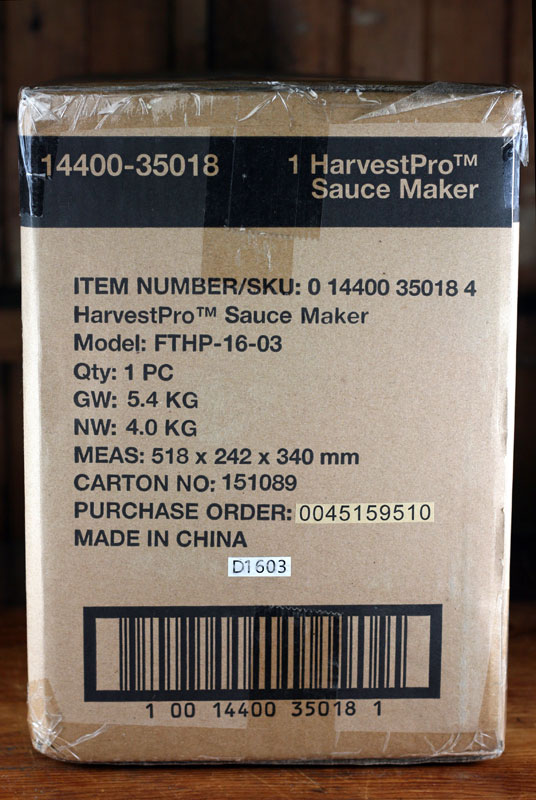
External shipping box. It give the weight and dimensions of the HarvestPro Sauce Maker package as shipped.

External shipping box
Fitting the HarvestPro back in the box
For those who want to keep the HarvestPro in its original box in order to keep all the pieces together, fitting them all back in can present a real jigsaw puzzle and be an exercise in frustration.
Thanks to Lyle Cameron for taking these photos while unboxing a brand new one, to record what parts go where.
Where to buy the Ball® HarvestPro™ Sauce Maker
You can buy this at Walmart online, or on Amazon.
(Canadians: don’t necessarily buy it from Amazon.ca — it is often far cheaper even with any exchange rate to buy from Amazon.com here, who will handle the border nonsense for you as well and guarantee you no surprise duties or tax at the door. In fact, Amazon.com gave us a rebate on some of the fees a few weeks later, as they had overestimated! In any event do not pay more than $150 to $200 CDN for it — there are some bizarre prices that appear on Amazon from time to time.)
Many other stores are also selling the machine.
References





